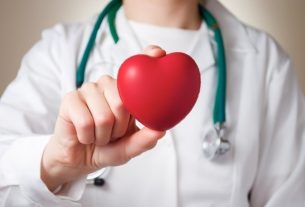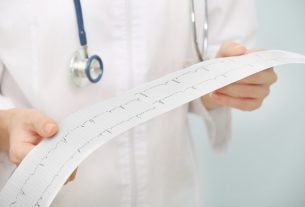Supraventricular tachycardia is a disorder that generates changes in electrical impulses in the upper part of the heart, called the atrium, causing an increase in heart rate, and which can lead to symptoms such as palpitation, dizziness, a feeling of heaviness in the chest, tiredness or shortness of breath.
This tachycardia may be favored by family history or occur due to certain situations, such as stress, infection or excessive consumption of alcohol or caffeine, for example. Learn about other causes of tachycardia.
Confirmation of supraventricular tachycardia can be done through a physical examination, where the doctor may also request some tests, such as an electrocardiogram and Holter, to assess the causes and indicate appropriate treatment, which may involve the use of medication or the performance of some procedures, such as placing a pacemaker or catheter ablation, for example.

Supraventricular tachycardia symptoms
Supraventricular tachycardia may not be noticed by the patient if it occurs rarely and isolated. In some people, palpitations may appear and persist, leading to a feeling of a racing or racing heart. These arrhythmias can appear suddenly and disappear quickly and without the need for any intervention, however, in some people, they can last for longer, up to hours or days, which can lead to symptoms such as:
- Palpitations;
- Dizziness;
- Excessive tiredness;
- Feeling of heaviness in the neck and chest;
- Shortness of breathe;
- Excessive sweating;
- Chest pain;
- Fainting.
In children and babies, the main symptoms may include excessive sweating, lack of appetite, paleness and rapid pulse.
In cases where symptoms persist for minutes, it is recommended to seek urgent medical assistance, avoiding complications such as fainting, cardiac or cerebral ischemia.
Main types
Supraventricular tachycardia can be classified into several types according to the causes and symptoms, the main ones being:
1. Atrioventricular reentry tachycardia
Atrioventricular reentry tachycardia is the most common type of supraventricular tachycardia, where the heart uses an extra route for transmitting electrical signals, causing the heart to beat before the appropriate time.
People with this type of change have very fast heartbeats, with more than 100 beats per minute, and which have a very short onset and duration. This type of tachycardia is very common at all ages, but happens more frequently in young women.
2. Atrial tachycardia
In atrial tachycardia, the electrical signal that controls the heartbeat occurs in a different location in the heart and is repeated very quickly, accelerating the heartbeat, which is equal to or greater than 100 beats per minute, leading to symptoms such as palpitations, fainting, dizziness , chest pain or cardiac arrest.
This type of tachycardia can occur in children with congenital heart disease or who have undergone heart surgery. However, the main causes of this type of supraventricular tachycardia include anxiety, stress, high blood pressure, previous heart attacks or excessive consumption of alcohol, cocaine and other stimulants.
3. Junctional atrioventricular tachycardia
Junctional atrioventricular tachycardia is characterized by an increase in electrical signals within the bundle of His, a set of fibers located within the heart, generating tachycardia, with 120 to 200 heartbeats per hour, and can lead to symptoms such as palpitation, shortness of breath of air, paleness and faintness.
This type of tachycardia is more common in young people, and is generally hereditary, but can also be caused by excessive use of drugs or alcohol, anxiety, and can appear after heart surgery.
Causes of supraventricular tachycardia
The main causes of supraventricular tachycardia are:
- Previous cardiovascular disease, such as heart attack, atherosclerosis or stroke;
- Wolff-Parkinson-White syndrome;
- Chronic lung disease;
- Excessive alcohol consumption;
- Use of stimulant drugs, such as cocaine and methamphetamines;
- Excessive consumption of coffee;
- Smoke;
- Thyroid diseases;
- Pregnancy.
Furthermore, the use of some medications to treat asthma, flu and allergies may also be related to the appearance of supraventricular tachycardia.
How to confirm the diagnosis
The diagnosis of supraventricular tachycardia must be made by a cardiologist, through physical assessment and the symptoms presented by the person, in addition to taking into account the person’s health history and that of the family.
In addition, the doctor may order some more specific tests to diagnose the type of tachycardia, such as electrocardiogram, 24-hour Holter, echocardiogram and exercise test. In some cases, blood tests may also be indicated to assess kidney and thyroid function. Find out about the tests that evaluate the heart.
How the treatment is carried out
Treatment for supraventricular tachycardia should only be carried out under the supervision of a cardiologist and aims to balance the heartbeat and prevent worsening of symptoms, which may vary according to the type of supraventricular tachycardia the person has. Thus, the main types of treatment are:
1. Vagal maneuver
This type of treatment is only recommended for people with junctional atrioventricular tachycardia, where a massage is performed on the initial part of the carotid artery to stimulate the release of substances that reduce the heart rate.
2. Valsalva maneuver
This is a type of maneuver performed by the cardiologist that stimulates the nervous system, favoring the reduction of heartbeats. However, this maneuver can only be performed in people who have junctional atrioventricular tachycardia.
3. Cardioversion
Cardioversion is a therapy generally indicated in the initial treatment of supraventricular tachycardias, especially in cases of low blood pressure, where pads or stickers are placed on the person’s chest and an “electric shock” is applied using a defibrillator, a device that emits strong shocks, altering electrical signals and helping to restore normal heart rhythms.
4. Medicines
In some cases of supraventricular tachycardia, the cardiologist may prescribe some medications to help control the heart rate or restore normal heartbeats, such as ivabradine, verapamil, adenosine, propafenone, beta blockers (metoprolol or atenolol), or amiodarone, for example.
5. Catheter ablation
In catheter ablation, the doctor inserts a catheter into the person’s veins or arteries, which, when touching the heart, blocks abnormal electrical signals and restores normal heartbeats.
This procedure is generally indicated for some cases of tachycardia that do not require medication or for people who do not respond to treatment with medication.
6. Pacemaker
In rarer cases, the cardiologist may recommend the use of a pacemaker, where electrodes are attached to the walls of the heart, and a device that is placed next to the heart, monitors and controls the rhythms of the heartbeat. Understand what a pacemaker is and how it works.
7. Lifestyle changes
In addition to conventional treatments, the cardiologist, together with a multidisciplinary team, can recommend lifestyle changes to improve heart health, including:
- Eat a balanced diet, regularly consume fiber-rich foods such as whole grains, fresh fruits and vegetables, maintain a balanced intake of healthy fats such as olive oil and low-fat proteins, and avoid foods high in fat and sugar. Here are some tips for maintaining a balanced diet;
- Get a good night’s sleepsleeping between 7 and 9 hours a night to help reduce the production of stress-related hormones, such as cortisol and adrenaline;
- Practice regular physical activitysuch as walking or swimming, under the supervision of a physical education professional, to improve resistance, in addition to stimulating the production of hormones responsible for pleasure and relaxation, such as dopamine, endorphins and serotonin.
Additionally, some types of complementary therapies and exercises, such as yoga and meditation, and relaxation techniques are also recommended to relieve stress, helping to avoid tachycardia.

Sign up for our newsletter and stay up to date with exclusive news
that can transform your routine!
Warning: Undefined array key "title" in /home/storelat/public_html/wp-content/plugins/link-whisper-premium/templates/frontend/related-posts.php on line 12
Warning: Undefined array key "title_tag" in /home/storelat/public_html/wp-content/plugins/link-whisper-premium/templates/frontend/related-posts.php on line 13



